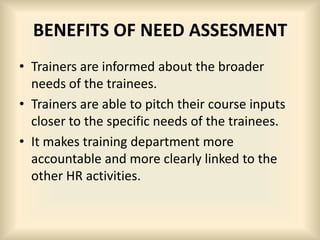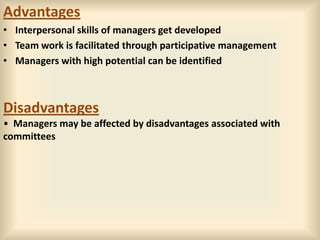Management development program.pptx_govind
- 2. PERFORMANCE DISCREPANCY Is it worth fixing Reward Inadequate Obstacles in KSA Deficiency punishment feedback the system incongruence Choose Change Provide proper Remove appropriate contingencies feedback obstacles remedy Job aid practice Change the job Transfer or terminate training
- 3. NEEDS ASSESSMENT • First step of training process. • Diagnosis of present problems and future challenges. • At two levels: group & individual
- 4. Needs assessment •Organizational support •Organizational analysis •Task & KSA analysis •Person analysis Instructional Development objectives of criteria Training Selection and validity design of instructional Transfer programs validity Intraorganiza training tional validiy Use of evaluation Interorganiza models tional validity
- 5. ISSUES IN NEED ASSESSMENT • Organizational support The analyst needs to take step to work effectively with all parties and gain the trust and support. • Organizational analysis Examining goals of the organization (short & long term) and the trends likely to effect the goals. • Task and KSA analysis • Person analysis
- 6. NEED ASSESMENT METHODS Group level Individual level Organizational goals Performance appraisal Personnel inventories Work sampling Exit interviews interviews Quality circles questionnaires Customer survey Attitude survey Current and projected changes Training progress Organizational climate indices Efficiency indices
- 7. BENEFITS OF NEED ASSESMENT • Trainers are informed about the broader needs of the trainees. • Trainers are able to pitch their course inputs closer to the specific needs of the trainees. • It makes training department more accountable and more clearly linked to the other HR activities.
- 8. CONSEQUENCES OF ABSENCE OF TNA Increased Lower quality of Poorer quality overtime & training personnel no. of personnel Higher pay, overtime premium, sup plement Higher Higher labor Loss of recruitment turnover business cost
- 10. • Management Development Programmes are the training methods for enhancing organizational performance through experiential learning. • Human Resources Development can be defined simply as developing the most important section of any business its human resource by, “attaining or upgrading the skills and attitudes of employees at all levels in order to maximise the effectiveness of the enterprise” (Kelly 2001)
- 11. • Human Resources Development is not a defined object, but a series of organized processes, “with a specific learning objective” (Nadler,1984) • Human Resources Development is the structure that allows for individual development, potentially satisfying the organization's goals.
- 12. Objective • A key feature of future top organizations will be to know how to boost the motivation and learning potential on all levels of the organization • “Its primary focus is on growth and employee development…it emphasizes developing individual potential and skills” (Elwood, olton and Trott 1996)
- 13. purpose of MDPs : • MDPs provide considerable intellectual stimulation. • Secondly, we acquire a nodding acquaintance with new concepts and new developments in the area of managerial techniques.. • The third benefits one derive from an MDP is the embellishment of one’s vocabulary-and this is good thing if the jargon is used circumspectly, and with the fact and understanding
- 14. • The program is designed to drive and support the individual development of these talents along the following core disciplines: • Personal Mastery, • Mental Models, • Building shared Vision, • Team Learning, • Systems Thinking.
- 15. 1. Personal Mastery – Openness to ongoing individual development in order to be ready for the continuously changing challenges in a learning organization, – to create a context for oneself that - as a creative network - stimulates learning and growth. 2. Mental Models – The reflection on the inner maps and the deeply ingrained assumptions that influence how we understand the world and how we take action. Above all, this means, – to comprehend the strong interconnections between our thinking and our actions.
- 16. 3. Building a shared Vision – Creating identification by building a shared‚ picture of the future and translating it into a set of principles and guiding practices. 4. Team Learning – Ability for effective communication, conflict solving and consensus building in work groups and teams, in order to make optimal use of existing resources and capacities.
- 17. 5. Systems Thinking – Thinking in complex interconnections – Evaluating organizational challenges in terms of interdependencies and effecting cycles – and developing effective ways to design systems
- 18. Management Development Off-the-job methods On-the-job methods • Lecture/Seminar •Coaching • Simulation exercise •Understudy • Behavior modeling •Job Rotation • Sensitivity training •Planned work Assignment • Transactional analysis •Internship
- 19. 1. On-the-job Management Development Methods Management development takes place on the job.It is learning by doing in the context of real work environment.
- 20. a) Coaching • It is actively guiding managers by their experienced immediate supervisors.The coach gives the guidance through direction, advice, criticism and suggestions. • If the coaching is done by someone other than the immediate supervisors, it is called mentoring.
- 21. Advantages • This methods provides oppurtunities for interaction between the coach and the learner. • There is rapid feedback of the performance • Learners are self motivated Disadvantages •Heavy reliance is placed on the abilities of the coach.This may limit the scope for development. •Managers may be unwilling or unable to coach
- 22. b) Understudy Assignments • Trainee managers are given staff posts under an experienced manager with”Assistant to” title • Trainee get the chance to learn the job under outstanding managers Advantages • The understudy managers gain valuable knowledge and experience • They become important source for filling up vacants posts in future. Disadvantages • The trainee may be unable tomake major decisions • The chances for errors are high
- 23. c)Job Rotation • It involves shifting managers from position to position.It can be: (i) Planned Rotation: Managers spend two or three months on a job and are then moved on.They learn several different jobs. (ii) Situational Rotation: Shifting is done to meet work schedules or to make the job challenging to the manager (iii) Line and staff Rotation: Managers can be shifted between line staff positions.
- 24. Advantages • Managers can broaden their experience and become familiar with variety of jobs • Specialists managers can be developed as generalists • Boredom and monotony in jobs are reduced • Managers evaluation is facilitated Disadvantages oRotated managers have little knowledge when shifted to new tasks.Productivity may suffer. oCosts of rotation may be high
- 25. d) Planned work Assignments • They give managers oppurtunity to gain experience and develop ability.The assignments can be: (i) Heading a task force: To solve specific problems (ii) Committee membership: To participatr in decision making (iii) Special project assignment: To learn project management
- 26. Advantages • Interpersonal skills of managers get developed • Team work is facilitated through participative management • Managers with high potential can be identified Disadvantages • Managers may be affected by disadvantages associated with committees
- 27. e)Internship • It combines classroom-oriented theoretical knowledge with practical experience • Managers are interned in organizations for a specified period to work as employees to gain experience.
- 28. 2. Off-the-job Management development Methods • Most management development takes place off the job.Managers are removed from the stresses and demands of the workplace.They can focus on learning experience. • The methods widely used are:
- 29. a)Lecture/Seminar • Lectures are oral communication of information to managers by instructors • Participants get oppurtunity to acquire knowledge and develop their conceptual, analytical and technical skills
- 30. Advantages • Lectures can cover large group of audience simultaneously at low cost. • Large amount of information can be covered in short time. Disadvantages • Lectures lack active involvement of learners • There is no feedback from learners
- 31. (b)Simulation A mock-up of a real thing A case study not to analyze but to be experienced by the trainee Asked to be themselves, not to act Decisions have a real effect in the simulation Followed by a critique of what went on during the exercise 31
- 32. c) Behaviour Modeling • This method combines role play with modeling.It involves the following steps: (i) Model study : Participants watch film or video of model persons behaving effectively in problem situation (ii) Reinforcement:Trainers positively reinforce the participants by providing feedback about a trainee performance. (iii) Skill Transfer: Participants transfer the new skills on the job • Role Playing Creating a more realistic situation Usually one of human problems and conflicts Closely approximate a real situation Enhances their sensitivity, growth and development
- 33. • Advantages (i) This method emphasizes effective management practises through imitation of role models. • Disadvantages (ii) It is time consuming.
- 34. (d)Sensitivity Training • According to Chris Argyris “ it is a group experience to provide maximum possible opportunity for the individuals to expose their behavior, give and receive feedback, experiment with new behavior and develop awareness of self and of others” Changed attitude Interpersonal competence Organizational improvement 34
- 35. Advantages • Increased listening and observation skills • Increased tolerance for individual differences • Increased openness and trust with others • Improved conflict resolution skills Disadvantages •Increased anxiety levels of weaker individuals •Doubt about transfer of skills to jobs
- 36. e)Transactional Analysis This method views interactions between individuals and between groups as transactions. It holds that an individuals personally consists of three ego states. • The parent: Ego state of authority, superiority, controlling • The adult : Ego state of objectivity and rationality • The child : Ego state of impulses and emotion The parent and child ego states feel and react directly. The adult state thinks before acting.
- 37. • Advantages i)TA develops skills in interpersonal relationships.Managers can understand others better. ii)The quality of communication is improved between individuals and groups. iii)Managers can understand and improve their managerial style. • Disadvantages i)Hard evidence is lacking about the effectiveness of TA ii)The skills acquired may not be transferred to job







































